Civil Engineering Reference
In-Depth Information
Further information about ropes in mining installations can be found in Briem
(
1998
,
2001
), Damien and Terriez (
1995
), Fuchs (
1988
), Fuchs and Spacs (
1993
,
1995
), Rebel (
2001
) and Verreet (
2001
).
3.5 Rope Efficiency
3.5.1 Single Sheave, Efficiency
When a rope moves over a sheave, a loss of energy occurs due to the friction in the
rope itself, the deformation in the contact zone of rope and sheave, and the sheave
bearing. The tensile force S on the pulling side is higher than on the other side
where the tensile force is S - DS. As can be seen schematically in Fig.
3.84
, the
lever arms for these acting forces correspond in such a way that the momentum is
the same on both sides.
The rope efficiency is
g ¼
S
DS
S
:
ð
3
:
96
Þ
The force loss is decisive for rope efficiency. Using their test results, Rubin
(
1920
) and others were among the first to evaluate equations for calculating the
loss of force. Their equations have the disadvantage that the specific force loss
depends on the diameter of the rope in contradiction to the similarity rule.
Schraft et al. (
1997
) measured the force loss for wire ropes with different
constructions moving over sheaves made of steel. He used tensile forces in a wide
range and sheave diameters D = 10d - 100d (definition of D according to
Fig.
3.33
). From his test results and some results from Rubin (
1920
) and Hecker
(
1933
), he derived the equation for the loss of the specific rope force
1
:
33
:
DS
d
2
¼
D
d
c
0
þ
c
1
S
d
2
ð
3
:
97
Þ
Fig. 3.84 Wire rope moving
over a sheave
S
− ʔ
S
S

Search WWH ::

Custom Search